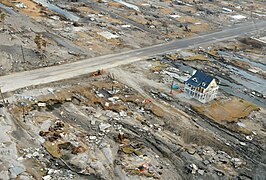
Back مرونة (هندسة وبناء) Arabic Resilienz (Ingenieurwissenschaften) German Kerksus Estonian تابآوری (مهندسی) Persian

In the fields of engineering and construction, resilience is the ability to absorb or avoid damage without suffering complete failure and is an objective of design, maintenance and restoration for buildings and infrastructure, as well as communities.[1][2][3] A more comprehensive definition is that it is the ability to respond, absorb, and adapt to, as well as recover in a disruptive event.[4] A resilient structure/system/community is expected to be able to resist to an extreme event with minimal damages and functionality disruptions during the event; after the event, it should be able to rapidly recovery its functionality similar to or even better than the pre-event level.
The concept of resilience originated from engineering and then gradually applied to other fields. It is related to that of vulnerability. Both terms are specific to the event perturbation, meaning that a system/infrastructure/community may be more vulnerable or less resilient to one event than another one. However, they are not the same. One obvious difference is that vulnerability focuses on the evaluation of system susceptibility in the pre-event phase; resilience emphasizes the dynamic features in the pre-event, during-event, and post-event phases.[5]
Resilience is a multi-facet property, covering four dimensions: technical, organization, social and economic.[6] Therefore, using one metric may not be representative to describe and quantify resilience. In engineering, resilience is characterized by four Rs: robustness, redundancy, resourcefulness, and rapidity. Current research studies have developed various ways to quantify resilience from multiple aspects, such as functionality- and socioeconomic- related aspects.[5]
The built environment need resilience to existing and emerging threats such as severe wind storms or earthquakes and creating robustness and redundancy in building design. New implications of changing conditions on the efficiency of different approaches to design and planning can be addressed in the following term.[7]
Engineering resilience has inspired other fields and influenced the way how they interpret resilience, e.g. supply chain resilience.

- ^ "Motivating business to design a more resilient nation, one building at a time" (Press release). Albuquerque, N.M.: Sandia Natiional Laboratories. 23 July 2013. Archived from the original on 2021-06-29. Retrieved 2019-07-03.
- ^ Jennings, Barbara J.; Vugrin, Eric D.; Belasich, Deborah K. (2013). "Resilience certification for commercial buildings: A study of stakeholder perspectives". Environment Systems and Decisions. 33 (2): 184–194. doi:10.1007/s10669-013-9440-y. S2CID 108560144.
- ^ Herrera, Manuel; Abraham, Edo; Stoianov, Ivan (2016-02-13). "A Graph-Theoretic Framework for Assessing the Resilience of Sectorised Water Distribution Networks". Water Resources Management. 30 (5): 1685–1699. doi:10.1007/s11269-016-1245-6. hdl:10.1007/s11269-016-1245-6. ISSN 0920-4741.
- ^ "What is critical infrastructure? Why is resilience important?".
- ^ a b Sun, Wenjuan; Bocchini, Paolo; Davison, Brian (2018). "Resilience metrics and measurement methods for transportation infrastructure: the state of the art". Sustainable and Resilient Infrastructure. 5 (3): 1–32. doi:10.1080/23789689.2018.1448663. S2CID 134122217.
- ^ Bruneau, Michel; Chang, Stephanie E.; Eguchi, Ronald T.; Lee, George C.; O’Rourke, Thomas D.; Reinhorn, Andrei M.; Shinozuka, Masanobu; Tierney, Kathleen; Wallace, William A. (November 2003). "A Framework to Quantitatively Assess and Enhance the Seismic Resilience of Communities". Earthquake Spectra. 19 (4): 733–752. doi:10.1193/1.1623497. ISSN 8755-2930. S2CID 1763825.
- ^ "A Theory of Value in the Built Environment", Value in a Changing Built Environment, John Wiley & Sons, Ltd, 2017-11-10, pp. 29–49, doi:10.1002/9781119073666.part2, ISBN 978-1-119-07366-6
© MMXXIII Rich X Search. We shall prevail. All rights reserved. Rich X Search